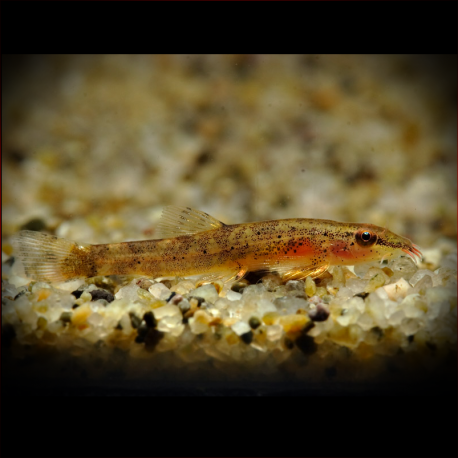More info
Datasheet
| Minimum Tank Size | 40 litres / 10.57 US gallons |
| Maximum Size | 2.5cm / 0.98inches |
| Temperature | 23°C / 73.40°F - 26°C / 78.80°F |
| Hardness | 0.00dgH / 0ppm - 5.04dgH / 90ppm |
| pH | 3.5-6.5 |
General Description
Neohomaloptera johorensis, commonly known as the lizard loach, is a diminutive schooling cyprinid with a distinctive orange to reddish-brown body coloration. It is a peaceful species, typically reaching a maximum size of 2.5 cm, with specialized morphology for life in fast-flowing waters, featuring horizontally extended paired fins and a flattened body conducive to clinging to solid surfaces.
Aquarium Setup
For optimal care of N. johorensis, a well-oxygenated environment free of organic pollutants is vital, avoiding torrent-like conditions. The tank should have a soft sandy substrate, driftwood, dried leaf litter, and hardy aquatic plants such as Microsorum and Cryptocoryne spp. To ensure stability, cover the tank securely, preventing potential jumps common in loaches. The species thrives in stable water conditions with a pH range of 3.5-6.5, hardness of 0-90 ppm, and a temperature of 23-26°C (see table).
Behaviour
This species is known for its peaceful temperament, making it suitable for community tanks with compatible tankmates. It thrives when kept in groups of four or more individuals, showing no aggression towards conspecifics or other fish. However, caution should be observed as eggs and fry may be susceptible to predation due to the loach's feeding habits.
Feeding and Diet
N. johorensis is a specialized grazer, feeding on biofilm, small crustaceans, insect larvae, and invertebrates in its natural habitat. In captivity, a diet of live or frozen foods such as Daphnia, Artemia, and various worms is essential for its well-being. While some sinking dried foods may be accepted, a diet rich in live foods is preferred for optimum health.
Reproduction & Dimorphism
Limited information is available on the breeding habits of N. johorensis, with no recorded instances in aquarium settings. Sexually mature females are slightly larger and fuller-bodied than males, serving as a potential dimorphic characteristic in this species.
Habitat and Distribution
In the wild, N. johorensis is commonly found in peat swamps, blackwater streams, and still waters with submerged vegetation in Malaysia and Indonesia. The species is associated with areas featuring brown, acidic water with minimal mineral content and abundant organic material. Its distribution spans regions in Peninsular Malaysia and parts of Indonesian Borneo, reflecting its preference for specific environmental conditions.

